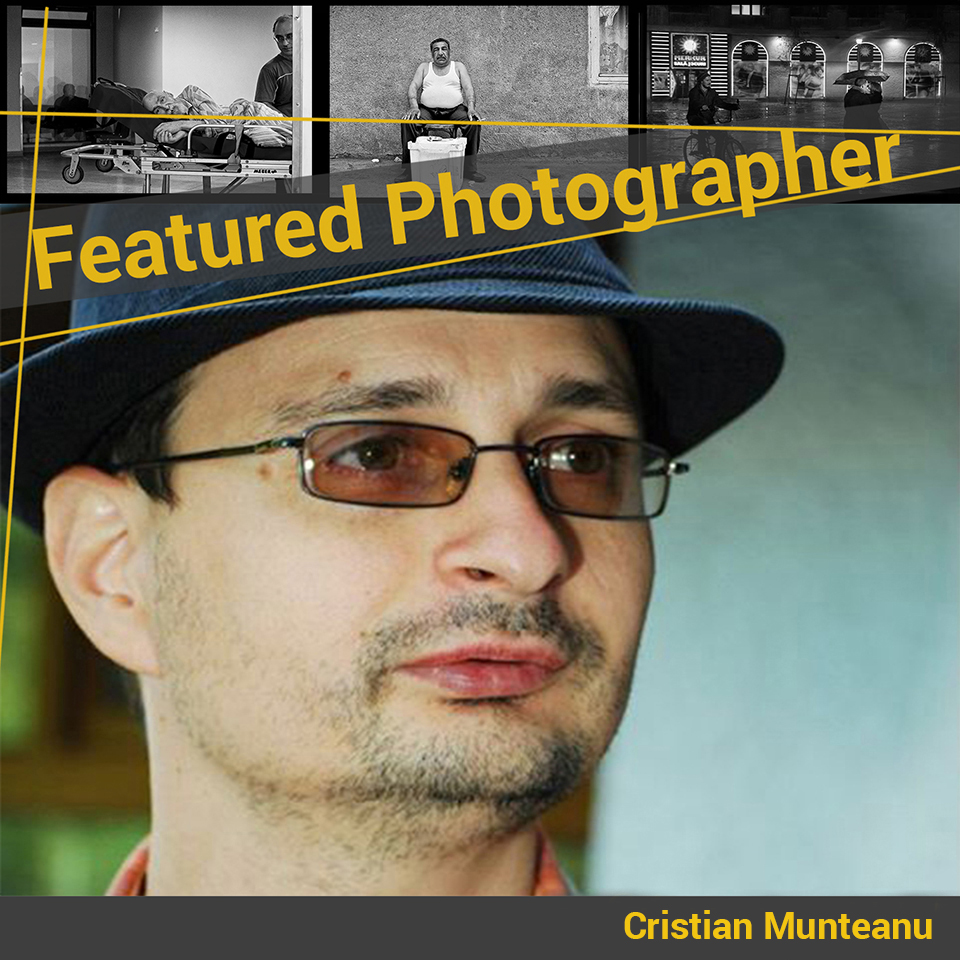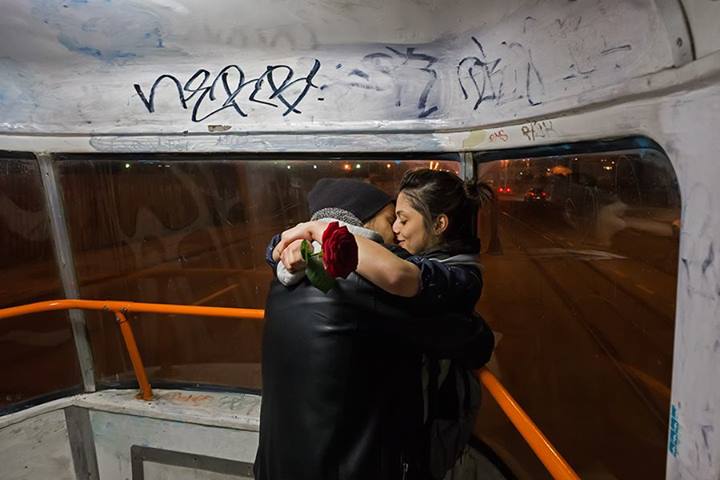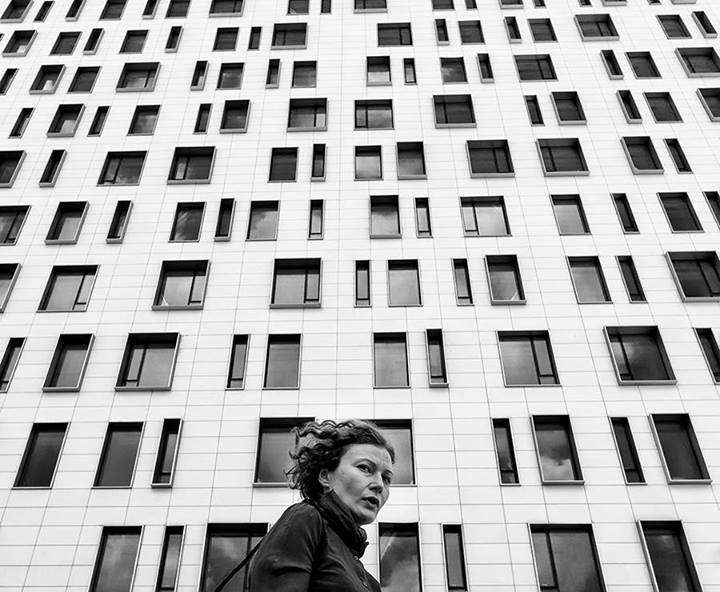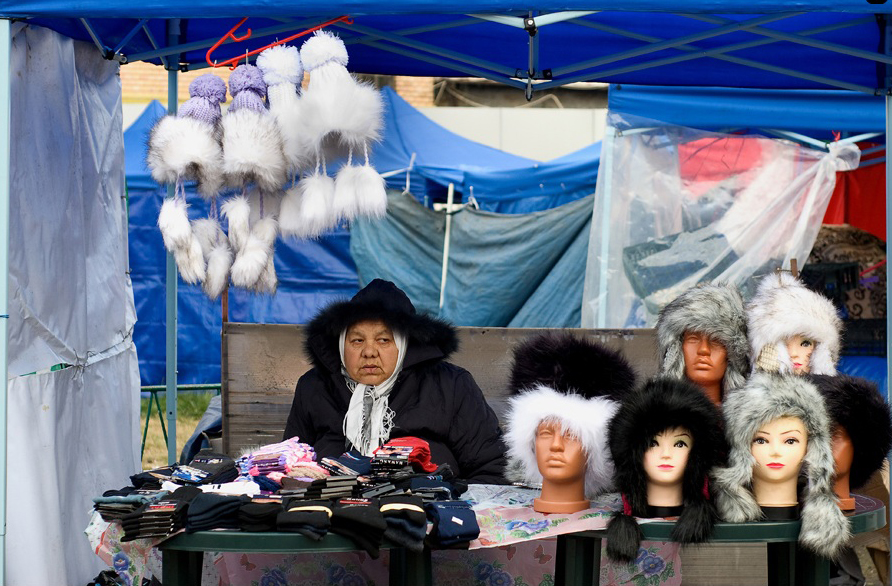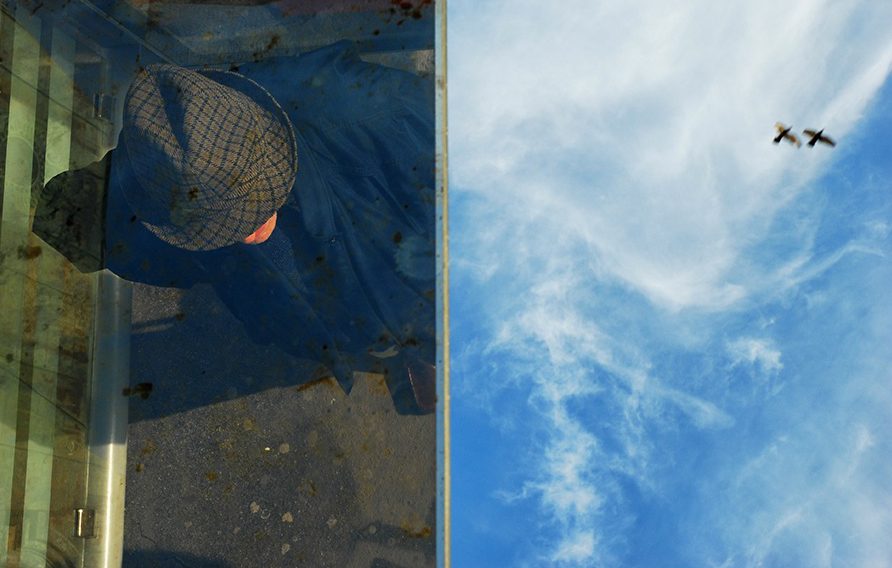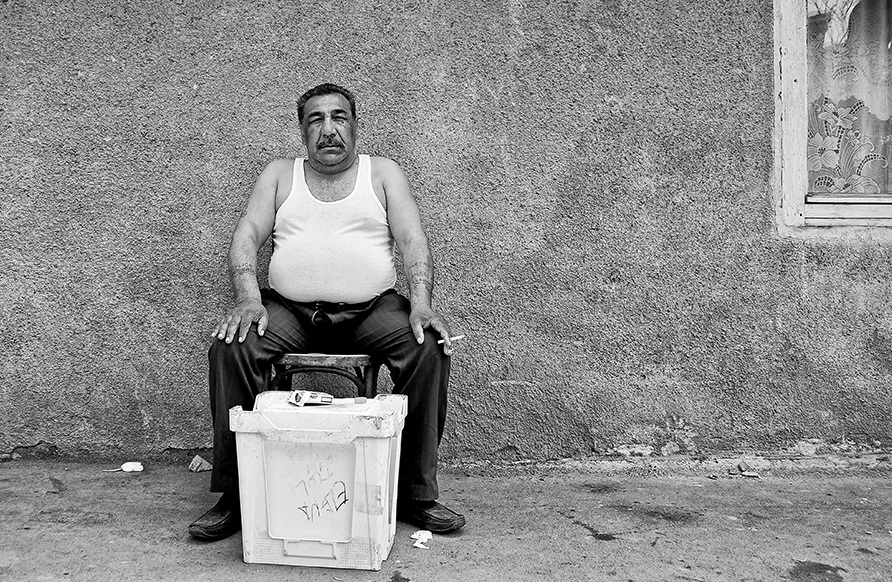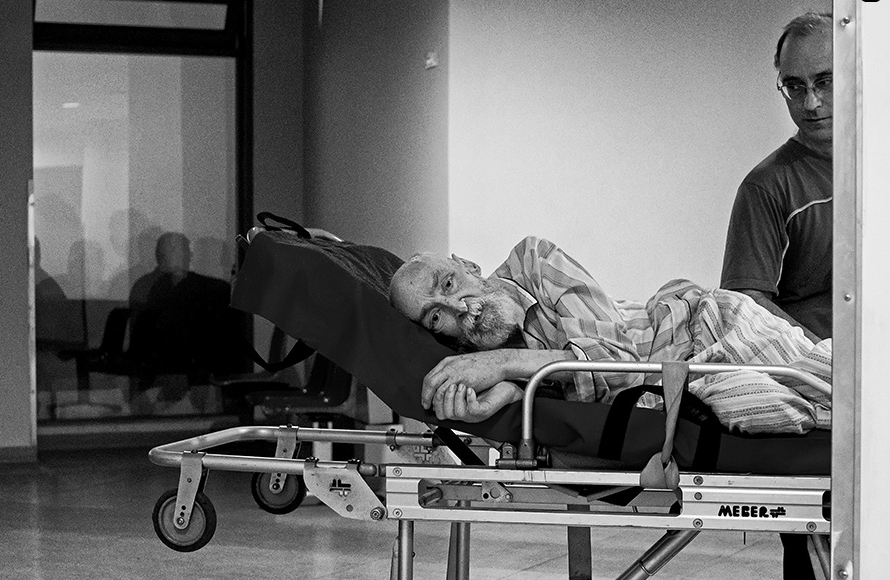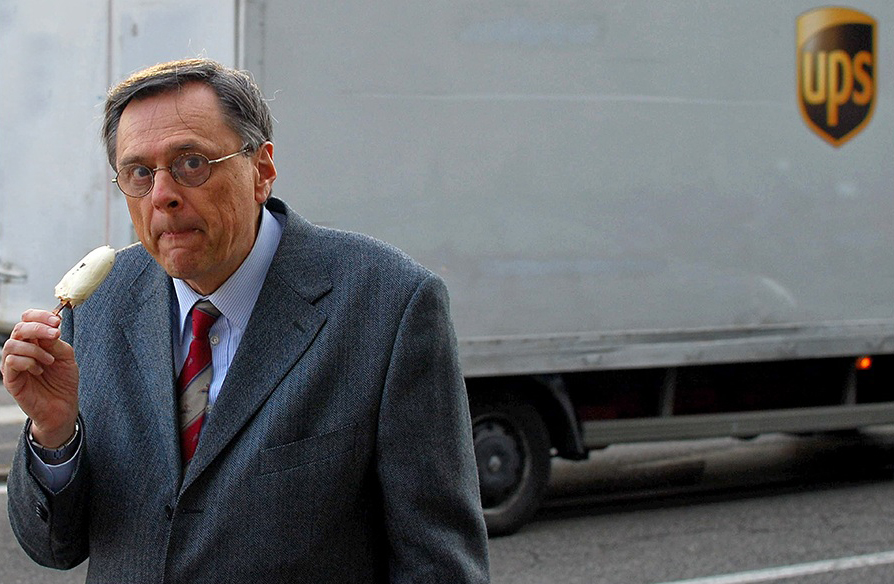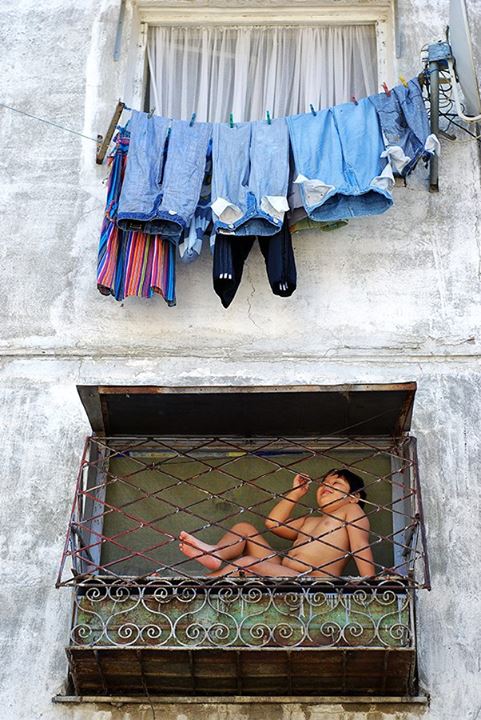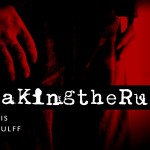Interview with Cristian Munteanu | Romania
Hello Cristian Munteanu, we are honored to be able to interview you for our Featured Photographer format on www.streetviewphotography.net!
Please tell us a little bit about yourself to begin with.
Hello everyone. First of all, thank you for the invitation. When this interview has started, i was 34 years old. Now i’m one year older. I was born, raised and I am still living in Bucharest, the capital of Romania. I am a sports journalist by profession, liking the “word” since I was little. Nowadays, I left writing aside but not reading, focusing more on image. But what I hope to do at some point, I don’t know how, I don’t know when, is to combine the word with the image.
Seeing your remarkable work, I am curious where your creativity comes from?
Thank you for the appreciation. I don’t know exactly. There may be a strong connection between imagination,anticipation and the capacity to observe. When I was little, I was playing with some wire knitted toy soldiers, for whom I was creating all sorts of scenarios. In general, 25-30 years ago, the toys were far more challenging to the imagination.Then you were playing with the toys and today they are playing with you. Now the focus is more on the visual, on capturing the attention without you doing something. Then, I have not finished any photography school, course or something and this allowed me to evolve, maybe in a crooked way, how I felt. What is most dangerous to such schools is, maybe paradoxically, not having a bad teacher, but a good one to give you the strong impression that you too saw the photography in the same way, but you were not able to systematize everything. Then you borrow something already chewed up and it is very difficult to break away from a philosophy that doesn’t belong to you. However I believe in the workshops with great photographers, capable to guide and correct, not indoctrinate you.
One thing that I enjoy doing is watching photos everyday. From Magnum, from press agencies in general. Maybe this helps too.
Could you share with us how you first became interested in street photography?
(Tell us the story of why and how you started. How long have you been shooting street photography?)
It was in the nature of things. There is no unique moment that determined me. When I put my hands on the camera with the intention of doing something serious, I simply went out in the street. Later i figured out that my mind wanted a challenge, to encapsulate in a picture the order or the extraordinary of the trivial daily chaos. As I also felt that I liked photojournalism. When there was the first manifestation in town, I went there. Besides photojournalism, photo-documentary, there is no other genre to offer a wider feeling. I feel useful when I do this type of photography. I’d like to tell a beautiful, sophisticated moment, when I had an epiphany about street photography. I don’t have one. My structure led me to it. The books, the movies, the music and the people within me.
You are an Administrator for Street View Photography Romania . Tell us a bit about your experience, how it all started and where do you want to take it.
It all began when what David did seemed it might be an experiment and then a solid project, with potential. The experiments on SVP-Romania are at least interesting. Most of them are related to people who don’t understand why their pictures are not on the main page. You are trying to explain how you see things and some understand. Most of them remain with the feeling that you wronged them. But I try to be as objective as possible.
What I’d like you to do with this page is, first of all, to give confidence to less known people, maybe in the beginning of their road, but endowed, from my point of view. I consider that when an elite is built, which shuts itself off and congratulates itself between four walls, this risks becoming harmful to those that might grow. And I have the feeling this thing starts happening in street photography from Romania.
Seeing your pictures over the course of time, I am curious how your observational skills evolved from a normal eye to they eye of a sensitive photographer.
A strange thing happened here. About 10 years ago, I was writing poems. However, not like a true poet but starting from images. I was putting in words what I was seeing in my mind. As such, as I realize, and I may be wrong, I always had an eye for images at some level, not very great. But, indeed, in time I evolved. I am saying this looking over my photos taken some years ago. I am still taking a lot of bad photos but the good ones are in a larger proportion as compared to when I started off. Another thing that helped me was the multitude of movies that I keep watching, at least 4 per week, and also looking at the paintings. From there you remain with frames, it’s also some training for the eye.
How much does your equipment help you to execute your artistic vision?
If you had asked me a couple of months ago, my answer would have been a little bit different. Meanwhile I experienced the power of full-frame cameras. Although I was and I am very satisfied with my mirrorless camera, Sony Nex 5N, the images that I took with a full-frame camera, regardless of whether was a Sony α99,Canon 5D Mark III or a Nikon D600, are something entirely different. However, in essence I don’t care much what camera I have. It must do a quick AF, to be small, unintrusive, to have all the basic settings at hand or to be customizable and to have a decent noise at high ISO levels. That’s all. And because of this my images come very close to those coming out straight from the camera. Therefore, a Sony Nex 5N and two lenses, a 19mm f/2.8 and a 30mm f/2.8,( i.e. 28.5 mm and 45 mm in full-frame equivalent – 35 mm). I don’t go out with something else in the street, and much less with a tele lens kit because I don’t want that the shooting to become wild photography. To take photos with a 100mm, 200mm, 300mm lens, is like shooting lions with a sniper rifle in Serengeti from 2 km. That is some sort of cowardice. If you have what it takes, go with a knife or spear. I have only one such photo, the one below, taken in my first two months of photography with a 70-300mm lens.
Can you tell us about your work flow from the point you first step onto the street until you showcase the developed picture?
(also share about the achievements you made, awards you received throughout your street photography career)
It’s simple. I take my camera, my lenses, the two batteries and I go out. If I have more time available I try to go where I haven’t been, if however the time is short, I will go on the roads I already know in search of new happenings. I never watch the photos in the same day because I got toasted more times due to the emotional factor. You have the feeling that you took a good photo, you download it, process it and quickly post it but it proves to be poor. So I let more days pass and then I try to be a bit more objective. Another difference I make is between the photos uploaded on Facebook and the others on my personal website. Facebook accepts even those less fine :).
I only participated at three contests so far; one in Romania, where I didn’t win any prize and the others at Sony World Photo Awards where I was in the first 50 at Open Competition, Split Second in 2013 Category and in the first 50 at Open Competition, Smile Category in 2014.
What is it in your subjects that makes you want to capture it?
Expressions, inner world. Coming either from feelings or thoughts. I’d like to surprise what’s happening within people reflected on their faces. Or in attitudes. I am not a big fan of geometry, excessive contrast, play of light and shadow. I find them most of the time devoid of content. Actually, my street photo I believe it to be rather a documentary street photo but not in the strict sense of the word documentary.
What would you say characterizes your work in comparison to other street photographers?
I am way too subjective to tell for myself, but I will try through the words of two Romanian photographers. Andrei Baciu said about my photos that: ‘[…] besides the ironic observation addressed to the morals of the contemporary Romanian society, your photos often prove an overwhelming tenderness’, and Cristian Crisbasan said that ‘they have gentle irony toward the human being and its shortcomings’. If two people approaching different styles, the first being a nature photographer and second a nude photographer, I see the same things at my frames, irony, tenderness, affection, I think this makes me different from the others. Beyond light, composition, stationary point, beyond rules, the subject is the one who makes your photo excellent or not. Even the Ansel Adams mountains look sometimes like people. And that because, willy-nilly, we always spin, in any art (even though I don’t know whether photography is really an art), around three themes: Life, Love and Death.
You have many spontaneous pictures. What can you tell us about the factor ‘luck’ in street photography?
I think there are not many but vast majority. All of my street photos are spontaneous, and subject notice me after the click of the camera. I try as much as possible to avoid the photos where the subject already noticed me or is looking straight at my camera, because the person will change physiognomy and the photo would lose authenticity. There are also images where the force of the moment and of the character change nothing of the reporting of the latter to me, and then everything is authentic.
Luck plays a bigger or a smaller role. If you sit in a place and shoot in continuous drive hoping that the agglomeration, for instance, has a second of order, and you capture it, you need a lot of luck. Generally speaking, good street photography pertains more to the photographer’s capacity to capture in a split second, the extraordinary. Yet, for you to be in a certain moment on a certain street and something out of order to happen there, requires some luck. But I don’t know many good photographers among the people lucky enough to find money in the street :)
In many of your images it seems that you are exactly on the right place at the right time. If we would split the street photography community into two categories, one is the ‘Roamer’ who walks around in order to find as many subjects as possible, and the other one is the ‘Camper’ who rather focuses on one place and camps out to wait until the right subject walks by, which street photographer would you be?
I cannot stand still while waiting for the metro or tramway, for instance, even before I started taking photos. Therefore, it is clear the category I fit in :). Yet, the moment I find a good “frame” I sit and wait. For instance, for the photo below, I was waiting around 1.5 hours on average, for five days in a row. I had visualized the entire photo in my mind, before I made it, but in real life the dog wasn’t there. So I went there every day hoping for one to pass by there and, in the same time, hoping the mannequin is not taken out of the window. Or that the plush dog is not put in a leash. And perseverance was finally rewarded.
Do you see your personality reflected in your work? And if yes, in what image does that come apparent to you.
Yes and no. I am ironic, even caustic sometimes, and I even have a trace of tenderness and all that are in my photos. What I don’t get is whether I like people or not. I don’t know if I have more than 10 photos of street without people in them, along the four years. Which, logically, means I like having people in the photos, I like seeing them live and I rejoice when the others see them through my photos. Yet I cannot figure out whether I like people or not.
Do you often interact with your subjects?
No, not really. Maybe this answers my previous misunderstanding :). But when the photos are requested of me, I always send them with pleasure. And sometimes I enjoy discovering more of the man I took the photo of. But, unavoidably, at a certain moment I start thinking about what other photos I am missing during this time. Street photography is not documentary photography, in the strict meaning of the genre, where story is also very important. But in my projects, which can be found on the website, I talk to my subjects. By all means, even only to put in context what is visible in my photos.
Among your work, which is your favorite and why?
This photo was taken this year, in a village with a strong community of Lipova Russians, whose name is Carcaliu. I had gone to photograph the Pentecost, and in the church service day, the image hereto happened. The women moved for a moment to the left and right, as a curtain opening, and the child appeared. I stood there for 10 minutes, taking 5-6 frames. The women were worshipping, were moving, and the boy was changing his posture. But what remained constant, and it is best viewed in the selected photo, is the loneliness of the child, his breaking off the context, which is more likely imposed. In a world of adults, the small sadness of a child who had stood a couple of hours, looked extremely eloquent. The contrast between the states made me trigger in the first place.
Did you ever take photograph which compromised your emotional balance in a deep and profound way?
Yes, I took. One, with a smaller impact, was the one whose link you can see, taken in a hospital in Bucharest. But the one that affected me most I did not take. I mean, it is not on digital format but in my mind. I had gone out from a supermarket and I heard a braking car. Screeching tyres. As I never go out without my camera, I went to take a look. As I was looking from behind the stopped car, I noticed the feet of the injured woman who had fallen on the walkway. I spun around and went home. I don’t think I am war photographer material.
Tell us your funniest or most awkward street photography story.
There is a man, around the building I live in, whom I photographed a day and he played an entire theatre scene, close to paroxysm, about the fact that he didn’t want to be photographed. I explained to him thoroughly that as long as he in public space, I could take photos of him, with the remark that I couldn’t publish and earn money from them, and then I left. After a month, I directed the camera to a guy with his cap pulled over his eyes who, when he got closer, was just my guy. He threatened to call the police because it was clear I was stalking him. Therefore, another scene. I asked him to call the police, I even wanted to stop a car myself but he said it wasn’t good as it was a traffic police car. When I saw he was not calling the authorized institutions, I left. And, a couple of weeks ago, at night, I returned home and I saw an old man on a bench in the light of a street lamp. I thought that a black-and-white would be worth trying, so I wanted to take a photo. Then, who dashed at my camera? The guy with the police. I got stuck. The third scene was so virulent that I suspect he did not take of quite orthodox business in his youth. Luckily, in Bucharest you get used, as a street photographer, with such individuals.
What are some of the most important lessons you have learned from shooting on the streets of Romania?
Oho, Bucharest is good for learning. As you need to be prepared to handle any kind of situation, with nervous, angry people who maybe refuse to be photographed in that very moment. Then, because the capital people are very suspicious, partly because of communism, partly because of a stupidly understood freedom, you learn how to be as little intrusive as possible, as discreet as possible. And then, because Bucharest is an ugly, bleak city, with chaotic buildings, so that you learn framing and composition without wishing it, while you keep trying to keep your images “clean”. After 2 years of photographing my city, when I went to Milano, I couldn’t understand why there were not posters, wires, pillars, garbage in any street. There was so much room for photography that there was the risk to take photos of anything, just for the sake of the city.
What would you tell a newcomer who asks for your advice on how to start street photography.
I’m not in the position to give advices to be honest. I’ve been trying for 4 years to do photography, and I am still far from being a connoisseur. But I can share from my experience so far. First of all, it is the interest. If life in the street seems fascinating to you, then it is worth. If not, studio is for you. Or landscaping. Then, courage. You have to be capable of facing people day by day. Then fast thinking, anticipation. The technical part, the capacity to discern what is special, what is extraordinary, what remains and what is left out of the frame, station point, I believe all these are learnt by practice. And, eventually, seeing other photos or going to a school. But it is sure by going out in the street almost every day, at least for 30 minutes. It is good training for the brain and the eye.
See more of Cristian Munteanu’s work here.
This content was created by the Street View Photography community – for the community of Street Photographers.

 Follow
Follow
